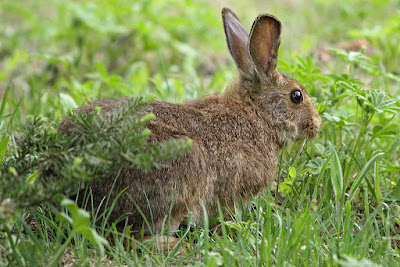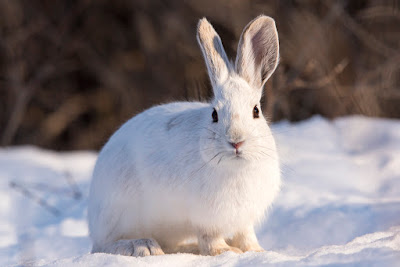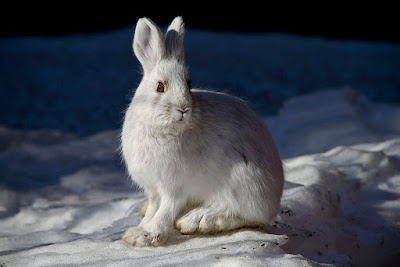The Snowshoe hare one of our commonest forest mammals, is
found only in North America.
Well-adapted to its environment, the snowshoe hare travels
on large, generously furred hind feet, which allow it to move easily over the
snow. The snowshoe hare’s ears are smaller than most hares’. The ears contain
many veins, which help to regulate body temperature. A seasonal variation in
fur color is another remarkable adaptation: from grey-brown in summer, the fur
becomes almost pure white in midwinter. The snowshoe hare one of our commonest
forest mammals, is found only in North America. The snowshoe hare is extremely
fast and agile, reaching speeds of 30 mph and jumping 12 feet in a single
bound. Well-adapted to its environment, the snowshoe hare travels on large,
generously furred hind feet, which allow it to move easily over the snow. The
snowshoe hare’s ears are smaller than most hares’. The ears contain many veins,
which help to regulate body temperature. A seasonal variation in fur color is
another remarkable adaptation: from grey-brown in summer, the fur becomes
almost pure white in midwinter.
Range
Snowshoe hares live in the coniferous and boreal forests of
the Rocky Mountains, the Appalachian Mountains, the Pacific Northwest, New
England, Alaska, Minnesota, Michigan, and Montana. Within the United States,
most of these coniferous forests are found on mountaintops, such as the Rockies,
or near the Canadian border.
Size
Adults weigh about 1.5 kilograms (3.3 pounds).
Food
In spring and summer, hares eat a variety of greens
including grass, clover, ferns and garden plants. In fall and winter, they eat
bark and the twigs of birch, aspen and conifers. In summer, the snowshoe eats
succulent vegetation and in winter, slender twigs, buds and bark. It has also
been known to nibble on the frozen carcasses of other animals and sometimes eat
their own droppings, which provide them with extra nutrition.
Behavior
The snowshoe hare is solitary, although it may share its
home range with other hares. It is most active at dawn and dusk and on cloudy
days. During the day, it spends most of its time grooming and napping. Snowshoe
hares are very good swimmers and can run at speeds of up to 27 miles per hour
and leap distances of up to 12 feet! When it is being chased be a predator, it
runs in a zigzag patterns that makes it difficult to catch.
Habitat
Snowshoes in Pennsylvania inhabit mixed deciduous forests
with conifers and escape cover, such as rhododendron and mountain laurel. They
favor younger brushy areas, those logged or burned seven to 10 years ago. Hares
also live in swamps where cedar, spruce or tamarack grow. Dense stands of aspen
or poplar, interspersed with pines, might support hares. In Pennsylvania, high
country such as ridge tops, mountains, high swamps and plateaus harbor most
hares.
As do cottontail rabbits, snowshoes move into forestland
opened up by fires, high winds, ice storms and clear-cutting. While cottontails
build up good populations in clear-cut areas in one or two years, snowshoes —
with a lower reproductive rate and different food and cover requirements — need
up to seven years to take hold. Browse cutting can help snowshoes by bringing
edible twigs within reach and encouraging the growth of shrubs, sprouts and
seedlings. Planting conifers, particularly spruce, and cutting tall trees to
keep them from shading out mountain laurel and shrubs will provide good cover.
Reproduction
Snowshoe hares first breed each year in March or April.
Their odd mating behavior is unlike that of any other native North American
animal. First, the male hare approaches and sniffs the female. Then he jumps in
the air, urinating on her from midair. The female sometimes does the same to
the male. Finally, they retreat to the brush to copulate.
The gestation period is just over one month. First litters
are usually produced from mid-April to May, and then the mating season begins
again. Females average two or three litters per year. In northwestern Montana,
females produce an average of 8 young per female per year. Newborn hares weigh
only 1.5 ounces when born but grow quickly, attaining adult weight within 3 to
5 months. If they survive 12 months, they are ready to breed.



















No comments:
Post a Comment